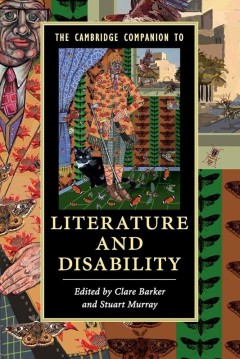Filter by

Portugal in the 21st Century
Portugal in the 21st Century provides a thorough yet accessible picture of contemporary Portugal in the first two decades of the twenty-first century. It examines and elucidates Portugal’s recent trajectory, its current position, and the main challenges it faces through an examination of the principal dimensions of cultural, economic, political, and social development in the country. Bringin…
- Edition
- -
- ISBN/ISSN
- 9781003488033
- Collation
- -
- Series Title
- -
- Call Number
- -

Tech giants, artificial intelligence, and the future of journalism
- Edition
- -
- ISBN/ISSN
- 9781351013758
- Collation
- -
- Series Title
- -
- Call Number
- -
- Edition
- -
- ISBN/ISSN
- 9781351013758
- Collation
- -
- Series Title
- -
- Call Number
- -

Literature and disability
- Edition
- -
- ISBN/ISSN
- 9781315726595
- Collation
- -
- Series Title
- -
- Call Number
- -
- Edition
- -
- ISBN/ISSN
- 9781315726595
- Collation
- -
- Series Title
- -
- Call Number
- -

Regional Cooperation and Resilience in East Asia
This book argues that a resilient region should act reactively and proactively in the face of shocks and disruptions and asserts that the institutionalization of regional cooperation may be the answer to development challenges in times of uncertainty and instability. It considers regional, transregional, and subregional cooperation initiatives for building regional resilience and critically ex…
- Edition
- -
- ISBN/ISSN
- 9781003458357
- Collation
- -
- Series Title
- -
- Call Number
- -

Social Justice Innovation in Africa
Adopting a multidisciplinary approach, this book discusses the potential of social innovation in the pursuit of social justice in Africa. In the twenty-first century, social innovation and entrepreneurship have attracted renewed attention as a way of promoting social justice and addressing challenges of poverty and inequality. Drawing on perspectives from human rights, economics, business, dev…
- Edition
- -
- ISBN/ISSN
- 9781003452423
- Collation
- -
- Series Title
- -
- Call Number
- -

How the World Hunger Problem Was not Solved
The world food crisis (1972–1975) gave rise to new development concepts. To eradicate world hunger, small peasants were supposed to use ‘modern’ inputs like high-yielding seeds, fertilizer, pesticides and irrigation. This would turn subsistence producers into business owners, transform rural areas, invigorate national economies and the crisis-stricken world economy and thus stabilize capi…
- Edition
- -
- ISBN/ISSN
- 9781003450337
- Collation
- -
- Series Title
- -
- Call Number
- -

The European Digital Economy Drivers of Digital Transition and Economic Recovery
The “digital economy” is a conceptual umbrella referring to markets, organizations and their networks that are based on digital technologies, communication, data processing and e-commerce. It is multidimensional and its dynamic structure must be analysed from various dimensions, such as economic – changes in the nature of resources, production factors and economic processes; technological…
- Edition
- -
- ISBN/ISSN
- 9781003450160
- Collation
- -
- Series Title
- -
- Call Number
- -

Rethinking migration and return in Southeastern Europe: Albanian mobilities t…
This book provides an important new analytical framework for making sense of return, remigration and circular mobility, conceptualising them as different phases of a wider migration process. Using an in-depth case study of Albania and its two main destination countries, Italy and Greece, the book demonstrates that instead of being viewed as a linear path between origin and destination, migra…
- Edition
- -
- ISBN/ISSN
- 9780429344343
- Collation
- 156 p
- Series Title
- -
- Call Number
- 334 GEM r

The performative power of vocality
The Performative Power of Vocality offers a fresh perspective on voice as a subject of critical inquiry by employing an interdisciplinary and cross-cultural approach. Conventional treatment of voice in theatre and performance studies too often regards it as a subcategory of actor training, associated with the established methods that have shaped voice pedagogy within Western theatre schools,…
- Edition
- -
- ISBN/ISSN
- 9780429340338
- Collation
- 260 p
- Series Title
- -
- Call Number
- 302 MAG p

Cities and local governments in Central Asia: administrative, fiscal, and pol…
This book presents the changing roles of urban governments and how local governments struggle to gain administrative, fiscal, and political power to combat current urban challenges in Kazakhstan. Focusing on the cities and regions selected by the national government of Kazakhstan to be the drivers of national economic development, the author analyses the impact of decentralization on the rol…
- Edition
- -
- ISBN/ISSN
- 9780429298752
- Collation
- 146 p
- Series Title
- -
- Call Number
- 337 JUN c
 Computer Science, Information & General Works
Computer Science, Information & General Works  Philosophy & Psychology
Philosophy & Psychology  Religion
Religion  Social Sciences
Social Sciences  Language
Language  Pure Science
Pure Science  Applied Sciences
Applied Sciences  Art & Recreation
Art & Recreation  Literature
Literature  History & Geography
History & Geography